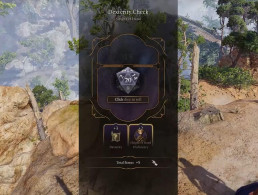Baldur’s Gate 3 is perhaps one of the best games to come out this year, perhaps the best RPG of the past decade. It’s a game that takes the whole genre to a new level and offers the freedom we fantasized about twenty years ago.
RPGs have been offering us freedom of choice for years. A great idea that in practice often comes down to choosing from a few flavors. average hero can be noble or as a cowboy shoot down every crook, but in the end he or she always achieves the same goal: the mission is completed. The game world you walk around in remains roughly the same and your primary path remains unchanged.
That’s certainly not the case in Baldur’s Gate 3. After your character escapes from a strange spaceship of dimension-traveling, mind-reading monsters, you set out to remove a parasite they introduced from your brain. You soon find out several ways to do that. You can search for a missing druid who may be able to heal you and save his camp, or team up with a group of goblins to drive the druids out of the forest. Or you forge an alliance with a captive dragon rider who knows another healer and skip about ten hours from the main story.
Throughout the game all kinds of small branches in the story are possible. Sometimes they are linked to your character. Are you playing a drow? Then the goblins will think you are one of their leaders, you are naturally so, and you can easily infiltrate their camps.
At other times, deviations are hidden behind dice rolls. Trying to convince a boss to surrender? You roll a 20-sided die, add your conviction score on top of it and cross your fingers that it is higher than you need to ‘win’ the conversation. If it works, you often don’t have to fight. Is your passive perception high and do you spot a secret door? Then you can sneak into the last room of a dungeon to steal unseen treasures.
The game is very explicit in how high you roll. If you actively roll a dice yourself, it will be large in the middle of your screen. If you walk around and miss something that your character could have passively noticed, a message will appear above their head. That emphasis on statistics makes the game look a bit mechanical, but you also notice continuously where the choices are hidden. As you play with your first character, you’ll mentally make notes of what else you could have tried to experiment with later in a second campaign, or third, fourth…



The game does a lot to offer variation outside those moments that have been made. For example, a paladin can break his oath and transform into an ‘Oathbreaker’, with a slew of new abilities and side missions. Or you can choose to give them the ‘Dark Urge’ when creating a character, which basically makes them a psycho with additional dialogue options. You can learn to talk to animals to discover new paths by talking to the local house cat, or cast a spell to resurrect the dead to interrogate them.
At the same time there is the Inspiration system, which rewards you with special points when you do something that fits a character. Do you play a rogue and rob someone? Chances are you’ll get a point for that. With that point you can retry a failed dice roll. It motivates you to stay in your role. Baldur’s Gate 3 is full of such nuances that make each play session unique. And where they remain on the surface in many other RPGs, our campaign went in completely different directions than that of friends.
Everything in the world of Baldur’s Gate 3 was put somewhere for a reason. It never feels like walking through dungeons from one redeemable battle to the next – you’ll find the cook and his sidekicks in a kitchen, a group of nobles in a ballroom. And because fighting isn’t your only option, everyone has a story and dialogue behind it. It brings the world to life in a way that’s rare in games, where orcs and cultists often serve as mere prey.


Battles take place in turns and are almost identical to those in the paper Dungeons & Dragons. You roll a dice at the start to see who can attack first, after which everyone can take turns doing something. On a turn, each character may move, perform a main action and a bonus action.
At its core this is quite simple, for example you walk up to an enemy, use the main action to ram your sword into him and have another healing spell that you can use as a bonus action. But due to multi-level spells, reactions, and other underlying systems, there’s a lot of nuance to consider. No problem for D&D veterans, but players who are just getting on now encounter a steep learning curve.
That learning curve is even steeper if you play with a controller. Then the interface consists of radial menus on top of radial menus, innocently popping every new skill and spell without prioritizing anything. You can try to sort everything, but that’s a lot of hassle. And because you don’t know the tricks of the trade in the beginning, it’s difficult to see at a glance which buttons are the most important to look at first. You come across big circles full of buttons you don’t know, which you have to read one by one to understand them. And then a few more times, because only when you understand the game rules will everything in those menus become clear.
Many functions are hidden in unexpected places. Four-point-press keys are shortcuts to extra functions, but do something else if you explain them for a long time, something that the game unfortunately does not explain clearly to you. If you want to understand the gamepad controls, it is best to do some homework on the local search engine, but that is obviously not the best solution.
Another point of criticism: at the time of writing you will find quite a few bugs in Baldur’s Gate 3. We haven’t encountered any game-breaking issues yet, but occasionally a conversation with an NPC would repeat itself or the camera would freeze. It certainly has to do with the early appearance, because developer Larian Studios released the PC version a month earlier to beat competitor Starfield.
And honestly: in a game of this scale and with so many variables that influence your play session, it’s special that we haven’t run into more problems. Anyway, Larian has already released several patches and we have no reason to suspect that they will stop doing so soon.
Baldur’s Gate 3 has now also ruined many old RPGs for us, simply because we expect more real consequences for choices made after this game. It is a game that raises the standard, which is almost unfair to other developers, it takes a small miracle to produce a game like this in peace.
That makes it one of the best RPGs of recent years, but at the same time it is one that we cannot recommend to just anyone. Because again: if you haven’t played Dungeons & Dragons before, you’ll need some hours to properly understand all systems in Baldur’s Gate 3. It can be difficult to get into the game, as you can say about a soul like. But at the same time that’s the charm: Baldur’s Gate 3 Makes no apologies or compromises. It’s made for a group of gamers who have yearned for an AAA production-quality RPG, but with unparalleled depth that in some areas only the most hardcore D&D enthusiasts can appreciate. A game not for everyone, but the best in its class.
Score:
9,5
+ Very faithful to Dungeons & Dragons
+ Strategic combat system
+ Lots of freedom of choice with real consequences
+ A detailed and vibrant game world
– Controller interface is very unclear
– Larger learning curve for non-D&Ders